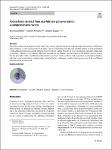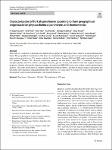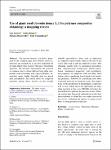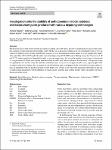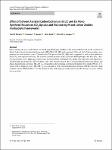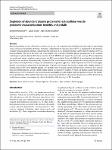Search
Author
- Carlos, Alegría (2)
- Carlos, Seara (2)
- David, Orden (2)
- Klaus, Bretterbauer (2)
- next >
Subject
Date issued
Has File(s)
- true (287)
Search Results
Kinetic, isothermal and thermodynamic studies for the oil spills removal process have been conducted by Chitosan and novel amphiphilic Chitosan-g-Octanal Schiff base adsorbents developed by click chemistry and evaluated successfully in the removal of heavy crude oil spills. Chitosan was first prepared from wastes of marine shrimp shells, and then Chitosan and Chitosan-g-Octanal Schiff base adsorbents were synthesized and verified their structures, thermal stability and their morphological changes using FT-IR spectroscopy, TGA and SEM. The oil adsorption percentages (%) using heavy crude oil were 96.41% for the Chitosan-g-Octanal Schiff base adsorbent compared to 64.99% for native Chitosan counterpart. High rate of adsorption was observed where 40% of oil adsorbed within 15 min only ... |
The glycosylation status of proteins is increasingly used as biomarker to improve the reliability in the diagnosis and prognosis of diseases as relevant as cancer. This feeds the need for tools that allow its simple and reliable analysis and are compatible with applicability in the clinic. With this objective in mind, this work reports the first bioelectronic immunoplatforms described to date for the determination of glycosylated haptoglobin (Hp) and the simultaneous determination of total and glycosylated Hp. The bioelectronic immunoplatform is based on the implementation of non-competitive bioassays using two different antibodies or an antibody and a lectin on the surface of commercial magnetic microcarriers. The resulting bioconjugates are labeled with the horseradish peroxidase ... |
Poly(ether)s represent an important class of polymers and are typically formed by ring-opening polymerization, Williamson ether synthesis, or self-condensation of alcohols. The oxa-Michael reaction presents another method to form poly(ether)s with additional functional groups in the polymer backbone starting from di- or triols and electron deficient olefins such as acrylates, sulfones, or acrylamides. However, research on oxa-Michael polymerization is still limited. Herein, we outline the principles of the oxa-Michael polymerization and focus on the synthesis and preparation of poly(ether-sulfone)s, poly(ether-ester)s, poly(ether)s, and poly(ether-amide)s. Further, challenges as well as future perspectives of the oxa-Michael polymerization are discussed. |
This study was conducted to determine the characteristic properties of Turkish pine honey, which is an important honeydew honey. The geographical classification of the honey was determined by applying carbon isotope, melissopalynological, and physicochemical analyses to 373 samples collected from 47 regions between 2015 and 2017 under controlled conditions. δ13C protein-δ13Choney, C4%, electrical conductivity, moisture, ash, free acidity, color CIEL* a*b attributes, optical rotation [α]20, proline, diastases activities, and sugars (fructose, glucose, sucrose, and maltose) were used as physicochemical properties. Number of honeydew elements /number of total pollen (NHE/NTP) ratios were studied at melissopalynological analyses. |
This paper describes first how Euclidian- and Minkowskian–Banach spaces are related via the definition of a metric or signature vector. Also, it is discussed later on how these spaces can be generated using homothecies of the unit sphere or shell. Such possibility allows for proposing a process aiming at the dimension condensation in such spaces. The condensation of dimensions permits the account of the incompleteness of classical QSPR procedures, independently of whether the algorithm used is statistical bound or AI-neural network related. Next, a quantum QSPR framework within Minkowskian vector spaces is discussed. Then, a well-defined set of general isometric vectors is proposed, and connected to the set of molecular density functions generating the quantum similarity metric matr... |
This work details the enzymatic generation of fluorescence nanomaterials and the use of this optical signal as the analytical parameter for the quantification of the substrate. More specifically, fluorescent copper nanoclusters have been obtained during the enzymatic reaction of tyramine oxidase and tyramine in the presence of Cu(II); the fluorescence intensity being proportional to the concentration of tyramine. The nanoclusters obtained show fluorescence at 445 nm by being excited at 320 nm and have been characterized by TEM, EDX, and XPS. The formation mechanism has also been studied, suggesting that under the optimal conditions (0.1 M MES buffer and pH = 6), the formation of the nanoclusters is due to the reducing properties of the product of the enzymatic reaction (p-hydroxyben... |
The massive biomass availability generated by the common giant reed (Arundo donax L.) motivates the research for its possible industrial use for high-added-value products through a biorefinery approach. The literature demonstrates the potential of common cane to obtain different high-value compounds, such as levulinic acid, oligosaccharides, fermentable sugars, highly digestible fiber for animal feed, polyphenols, and natural fibers for composite materials, among others. Arundo can also provide valuable lignocellulosic fibers with an application as composite reinforcement, which is the aim of this review. The work is split into different sections: fiber obtaining, mainly done by mechanical procedures, fiber characterization (composition, thermal degradation, "mechanical properties",... |
Blackcurrant juices were produced with an oxygen-excluding spiral filter press and two conventional pressing systems exerting common oxygen exposure at pilot plant scale (200 kg) in technological duplicate in two subsequent years (n = 4). In contrast to findings on previously studied fruits, contents of total and individual anthocyanins were not significantly higher after spiral filter (1636–1872 mg/L) than after conventional pressing (1529–2083 mg/L). During storage for 52 weeks at 4, 20 and 37 °C, anthocyanin levels depended strongly on storage temperature, but not on the used pressing system (conventional vs. oxygen-reduced). Other juice quality parameters like ascorbic acid behaved likewise. |
Direct mixing (de novo) and Solvent Assisted Ligand Exchange (SALE) are the main methods used for the synthesis of Mixed-Linker Zeolitic Imidazolate Frameworks (ML-ZIFs). ML-ZIFs with combined –NO2 and –Br/–Cl functionalities were prepared via both synthetic routes. Thereafter the CO2 uptake of the ML-ZIFs were compared, as well as their abilities to fixate CO2 with epoxide substrates. The de novo synthesis resulted in ML-ZIFs with SOD topologies, 60: 40 (–NO2: –Br/–Cl) functionality ratios, higher porosities, better thermal stability and higher CO2 uptake than equivalent SALE products. |
Blood extracellular vesicles (EVs) play essential roles in cell–cell communication and their molecular cargo is a promising source of disease biomarkers. However, proteomic characterization of plasma-derived EVs is challenged by the presence of highly abundant plasma proteins, which limits the detection of less abundant proteins, and by the low number of EVs in biological fluids. The aim of this study was to investigate if the removal of abundant plasma proteins prior to EV isolation could improve plasma-derived EV characterization by LC–MS/MS and expand the proteome coverage. Plasma depletion was performed using a single-use spin column and EVs were isolated from only 100 µL of non-depleted and depleted plasma by size exclusion chromatography. |



